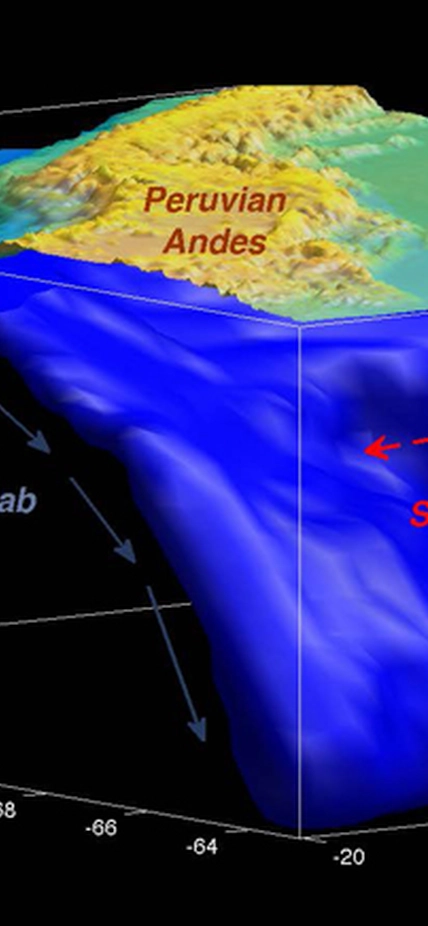Washington, D.C.—New observations from an international geophysics team, including Carnegie’s Lara Wagner, suggest that the standard belief that the Earth’s rigid tectonic plates stay strong when they slide under another plate and sink into the deep Earth may not be universal. Instead, the new work suggests that the Nazca slab in Perú may be relatively weak and deforms easily. The research is published in the November 23, issue of Nature Geoscience.
Typically during subduction, plates slide down into the mantle at a fairly steep angle, sinking at a constant rate into the warmer, less-dense mantle material. However, in a process called flat-slab subduction, the lower plate moves nearly horizontally underneath the upper plate, sometimes for great distances. A consequence of flat-slab subduction is that the volcanism and mountain formation that normally occurs within a couple of hundred kilometers of the plate boundary moves far inland. The largest flat slab is found beneath Perú, where the oceanic Nazca Plate is being subducted under the continental South American Plate.
Scientists image structures in the deep Earth by observing how seismic waves travel through it. The speed that different seismic waves propagate through Earth’s interior can reveal structural, compositional and dynamic features of what lies below. In particular, the crystals in the plate can form an organized fabric that results in seismic waves traveling at different speeds in different directions, a phenomenon known as seismic anisotropy
Oceanic plates form at mid-ocean ridges where plates are pulled apart and volcanism fills in the gap to create new crust that gradually moves away from the ridge. The movement of the plate causes the most abundant mineral in Earth’s interior, olivine, to align with the direction of plate growth. This olivine structure is then “frozen” into the oceanic plate and stays with the plate as it travels across the Earth’s surface. The aligned olivine cause seismic waves to travel at different speeds in different directions, depending on whether or not they are going “with the grain” or “against the grain.” In typical steep-angle subducting slabs, observing these subtle differences in seismic wave speeds within the down-going plate is very difficult. However, with the unique flat-slab geometry of the Nazca slab, seismic waves that travel through the deep part of the slab (below 125 miles, or 200 kilometers) are unusually accessible using land-based seismometers.
The scientists observed and measured seismic waves at 15 local seismic stations over 2 1/2 years from 2010 to 2013, and 7 distant stations located on different continents. They found that the data from distant stations, and the data from local readings, both suggested the exact same thing: the frozen olivine structure within the slab had vanished and been replaced by a new unexpected structure, in an opposing orientation to before. The best way to explain this observation is that the slab’s interior must have been stretched or deformed during subduction. This means that slabs are weak enough to deform internally in the upper mantle over time. After investigating several possibilities, the researchers believe that deformation associated with stretching of the slab as it bends to takes on its flat-slab shape was enough to erase the frozen olivine structure and create a new alignment that closely follows the contours of the slab bends.
“Imaging Earth’s plates once they have sunk back into the Earth is very difficult,” remarked Wagner, principal investigator of the PULSE Peruvian project. “It’s very exciting to see results that tell us more about their ultimate fate, and how the materials within them are slowly reworked by the planet’s hot interior. The original fabric in these plates stays stable for so long at the Earth’s surface, that it’s eye opening to see how dramatically and quickly that can change.”
Lead author of the study, Caroline Eakin of Yale and the University of Southampton in the UK, said: “The process of consuming old seafloor at subduction zones, where great slabs of oceanic material are swallowed up, drives circulation in the Earth’s interior and keeps the planet going strong. One of the most crucial but least known aspects of this process is the strength and behavior of oceanic slabs once they sink below the Earth’s surface. Our findings provide some of the first direct evidence that subducted slabs are not only weaker and softer than conventionally envisioned, but also that we can peer inside the slab and directly witness their behavior as they sink.”
Other researchers on the study are Maureen Long of Yale, Alissa Scire, Susan Beck and George Zandt of the University of Arizona, and Hernando Tavera of the Instituto Geofisico del Perú.
This work was supported by the NSF.
